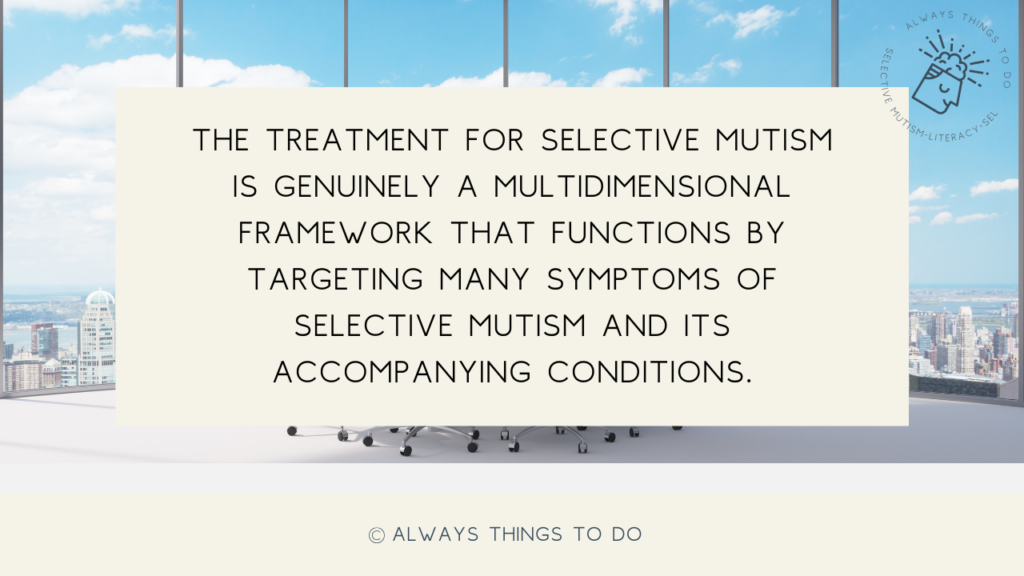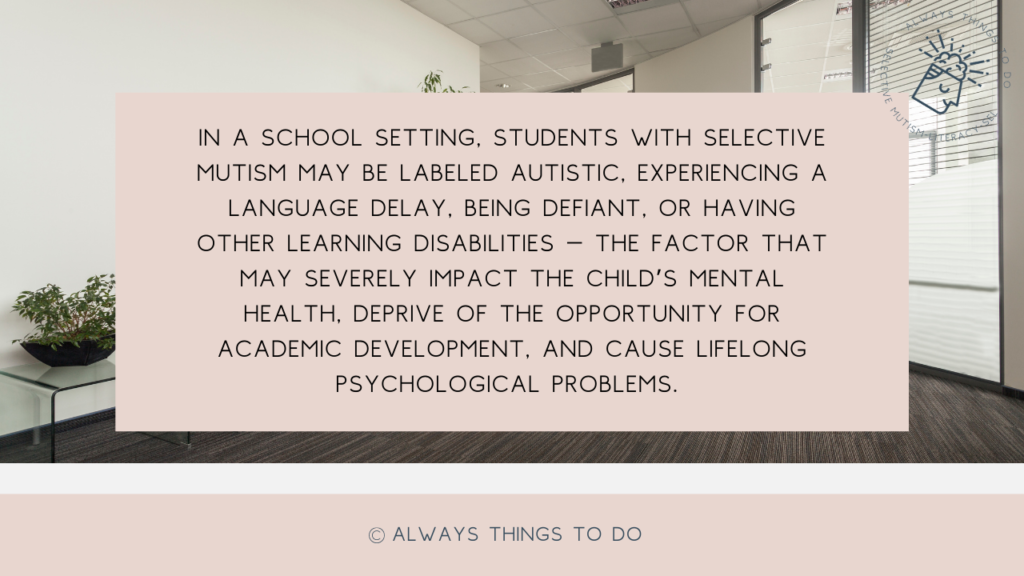How Do You Treat Selective Mutism?
This post will answer the following questions and talk about the following points:
- Is treating selective mutism hard?
- Is selective mutism rare?
- How do you treat selective mutism?
- Is selective mutism a speech disorder?
- Behavioral approach to treat selective mutism.
- Cognitive-behavioral approach to treat selective mutism.
- Pharmacological approach to treat selective mutism.
- Family therapy approach to treat selective mutism.
The treatment of many diseases and conditions such as heart disease, cancer, depression is currently robust and serious because of two main reasons:
- there is extensive research happening in these fields and technological advancement as a result,
- there is a massive growth in awareness about these illnesses and how they impact the quality of life.

While research about and understanding selective mutism has been developing steadily, limitations and knowledge gaps still exist.
Due to its rare nature, research about a selective mutism anxiety disorder is based on a small number of examined cases.
In addition, because manifestations of selective mutism are so individual and the accompanying conditions are so multiple (social anxiety, obsessive-compulsive disorder, depression, speech and language difficulties, developmental delay, etc.), the treatment for selective mutism is genuinely a multidimensional framework that functions by targeting many symptoms of selective mutism and its accompanying conditions.
From my family’s personal experience of tackling my daughter’s selective mutism, I can identify two major problems that needed to be targeted by treatment:
- lack of speaking (obviously),
- my child’s emotional well-being; the latter problem, surprisingly, is more severe and impactful.
Three years of a robust learning experience about selective mutism and consistent use of many tools to treat selective mutism anxiety disorder have shown me that my child’s treatment of selective mutism has gone through four major stages:
- awareness and knowledge building
- building a foundation for successful interventions (dealing with a high anxiety level first)
- implementing intervention at home and school
- medication
Is Treating Selective Mutism Hard?
The treatment of selective mutism for every child is a complex system of tools and interventions adjusted toward a particular child, and the degree of severity selective mutism has.
One of the most challenging aspects of selective mutism treatment is that this disability manifests in different ways and is often unnoticed or labeled as shyness.
Even though selective mutism directly impacts a child’s social skills (a child stopped talking in the social settings that cause anxiety), the impact varies greatly.
Some children are entirely withdrawn in all social settings, while others interact efficiently in a nonverbal manner. Apart from verbal communication, children with selective mutism show a variety of symptoms and behaviors that also have to be addressed as part of the treatment for selective mutism:
- tantrums
- fidgeting
- temper outbursts
- clinginess
- reluctant eater
- sensitivity to textures, sounds
- hair sensitivity
- sensitive to physical touch (hugging)
- stubborn
- easily frustrated
- defiant

Is Selective Mutism Rare?
Recent studies suggest that selective mutism occurs in 0.7% of children. This number, in fact, maybe misrepresented due to the lack of quality research and general awareness of selective mutism.
Children with selective mutism are often misdiagnosed by a pediatrician who has no experience or knowledge of selective mutism; kids are labeled as shy and are expected to outgrow in a while.
In a school setting, students with selective mutism may be labeled autistic, experiencing a language delay, being defiant, or having other learning disabilities – the factor that may severely impact the child’s mental health, deprive of the opportunity for academic development, and cause lifelong psychological problems.
Girls are diagnosed with selective mutism more frequently than boys. And the symptoms usually appear at the early age of three. However, selective mutism may not be registered and diagnosed up until the child enters school.

How Does the Understanding of Selective Mutism Impact the Design of Treatment?
Many theories have been developed over the years trying to explain the origin of selective mutism anxiety disorder.
From the perspective of psychoanalysis, selective mutism is viewed as a manifestation of unresolved internal conflicts(Cohen et al., 2006). May theories point to faulty family relationships (Anstendig, 1998). Other approaches name the traumatic event and abuse as the causes of selective mutism (Dow, Sonies, Scheib, Moss, & Leonard, 1995).
The current understanding of selective mutism points to social anxiety as the root cause (Cunningham et al., 2006; McHolm et al., 2005; Sharkey & McNicholas, 2008).
What it means is the current treatment for selective mutism revolves around addressing anxiety as the root cause of selective mutism.
Read this article to learn more about the causes of selective mutism and the guidance for parents.
Does Selective Mutism Directly Stem from Some Developmental Disorder?
Lisa Camposano reports on the research by Steinhausen & Juzi (1996), who studied 100 children with selective mutism. Of these 100 participants, 38% had a history of language delays and disorders. Other studies (Black & Uhde, 1995), in contrast, report no evidence of developmental delays among selective mutism participants, according to Camposano.
The bottom line, the mixed evidence concerning the connection between selective mutism and any developmental disorders shows that more research needs to be done in this area.
Read this article to learn about the reasons why selective mutism IS a disbility which impacts children in many ways, therefore, making them eligible for special education services and support in a school.
Is Selective Mutism a Speech Disorder?
Great question. Since the research in selective mutism has significant gaps and is abundant in contradictory findings, the answer to this question cannot be definitive.
However, in her article “Silent Suffering: Children with Selective Mutism,” Lisa Camposano (2011) reports that …
“researchers generally agree that selective mutism does not fall under the realm of speech/language disorders, communication disorders, defiant behavior, or shyness.”
According to other scholars (Kearney and Vecchio, 2007), selective mutism disorder is not related to such a communication disorder as stuttering, nor does it stem from a lack of language proficiency. Nevertheless, a tiny percentage of children with selective mutism disorder have speech and/or language difficulties (Schwartz et al., 2006.
How to Treat Selective Mutism?
Due to the scarcity of research examining effective treatment approaches towards selective mutism, researchers have no agreement about which approach and intervention are more reliable and effective.
Despite the lack of a unified approach to treating selective mutism, the common goals of any approach in treating selective mutism are to lower the child’s anxiety and develop coping mechanisms for tackling anxiety.
Another important goal is to increase verbal communication in social settings.
Behavioral Approach to Treat Selective Mutism.
Scientists who study behavior (behaviorists) view selective mutism as a learned behavior a child develops to cope with anxiety. Based on this view, the treatment of selective mutism is in lowering anxiety and increasing verbal communication. This approach incorporates reinforcement of speaking in a non-threatening way.
The most common technique from this approach is shaping. A treatment professional leads a child from the starting point of being non-verbal to gradually producing isolated sounds and, finally, using words, phrases, and sentences.
Other standard techniques are stimulus fading and systematic desensitization.
Stimulus fading is a technique when a child is gradually exposed to a larger number of people in the room or classroom as the child practices verbalization.
Systematic desensitization is a technique where a treatment professional sets goals of increasing difficulty with corresponding rewards for each leveled task completed by a child.
Cognitive-Behavioral Approach to Treat Selective Mutism.
While behavioral interventions can be very effective, especially for younger children, the behavioral approach and intervention do not address the child’s anxious thoughts.
I believe the transition from behavioral to cognitive-behavioral intervention for selective mutism is natural as a child matures and learns to think about their feelings and gain tools to restructure their thought process. And this is the essence of cognitive-behavioral interventions – restructuring of thought processes.
Cognitive-behavioral interventions focus on developing stress coping mechanisms that a child can gain to manage their feelings. A considerable part of this process is social-emotional education.
You might be already familiar with social-emotional education if you heard about such concepts as growth mindset, mindfulness, stress management, self-awareness, etc.
Pharmacological Approach to Treat Selective Mutism.
The pharmacological approach towards treating selective mutism is simply the prescription of medication. Even though medication is never recommended as the primary treatment for selective mutism, medication can be a massive boost towards the effectiveness of behavioral and cognitive-behavioral interventions.
Family Counseling/Therapy Approach to Treat Selective Mutism.
Many researchers study how selective mutism impacts family dynamics.
Meyers (1984), for example, reported on dysfunction within the families of children with selective mutism. Other studies talked about higher rates of marital conflict and divorce among families of children with selective mutism (Viana, Beidel, & Rabian, 2009).
The impact of selective mutism can be devastating for the whole family. I wrote earlier a gut-level reflection of our family’s coping with selective mutism and the hard times we have been through.
While it may be so easy for parents to mistakenly conclude that they have failed to provide proper upbringing for their child or even to see their child as having an oppositional behavior, the best way to switch this thinking into a healthier way of thinking is to seek family counseling.
My own experience tackling selective mutism with my daughter has taught me a lot about social and emotional development, mindfulness, meditation, and child psychology.
Despite the very handicapping nature of selective mutism anxiety disorder and its profound paralyzing impact on functioning in children, the successful treatment of selective mutism is possible, and it starts with parents’ educating themselves about selective mutism, advocating for their child at school and learning about the practical tools and interventions for selective mutism.
If you liked the information in this post, make sure you explore other posts about selective mutism:
- “What Is Selective Mutism?”
- “Selective Mutism: How To Beat Crisis, Screaming, and Fear.”
- Diagnosis of Selective Mutism: Simple Parent Guide and Steps to Take.
- What Are The Causes of Selective Mutism?
- Is Selective Mutism a Disability?
Check out the expanding library of tools. Go to the selective mutism page and scroll to the bottom section, “Latest Projects.”
Connect with me on social media @alwaysthingstodo.
Resource cited:
Anstendig, K. (1998). Selective mutism: A review of the treatment literature by modality from 1980-1996. Psychotherapy, 35, 381–390.
Black, B,, & Uhde, T. W. (1995). Psychiatric characteristics of children with selective mutism: A pilot study. Journal of the American Academy of Child and Adolescent Psychiatry, 34, 847–856.
Camposano, Lisa. (2011). Silent Suffering: Children with Selective Mutism. The Professional Counselor. 1. 10.15241/lc.1.1.46.
Cohan, S. L., Chavira, D. A., & Stein, M. B. (2006). Practitioner review: Psychosocial interventions for children with selective mutism: A critical evaluation of the literature from 1990-2005. Journal of Child Psychology and Psychiatry, 47(11), 1085–1097.
Cunningham, C. E., McHolm, A. E., & Boyle, M. H. (2006). Social phobia, anxiety, oppositional behavior, social skills, and self-concept in children with specific selective mutism, generalized mutism, and community controls. European Child & Adolescent Psychiatry, 15, 245–255.
Dow, S. P., Sonies, B. C., Scheib, D., Moss, S. E., & Leonard, H. L. (1995). Practical guidelines for the assessment and treatment of selective mutism. Journal of the American Academy of Child and Adolescent Psychiatry, 34, 836–846.
Kearney, C. A., & Vecchio, J. L. (2007). When a child won’t speak. The Journal of Family Practice, 56(11), 917–921.
McHolm, A. E., Cunningham, C. E., & Vanier, M. K. (2005). Helping your child with selective mutism: Practical steps to overcome a fear of speaking. Oakland, CA: New Harbinger.
Meyers, S. V. (1984). Elective mutism in children: A family systems approach. American Journal of Family Therapy, 12(4), 39–45.
Sharkey, L., & McNicholas, F. (2008). ‘More than 100 years of silence’, elective mutism: A review of the literature. European Child & Adolescent Psychiatry, 17(5), 255–263.
Steinhausen, H., & Juzi, C. (1996). Elective mutism: An analysis of 100 cases. Journal of the American Academy of Child and Adolescent Psychiatry, 35, 606–614.
Viana, A. G., Beidel, D. C., & Rabian, B. (2009). Selective mutism: A review and integration of the last 15 years. Clinical Psychology Review, 29, 57–67.


One Comment
Pingback: